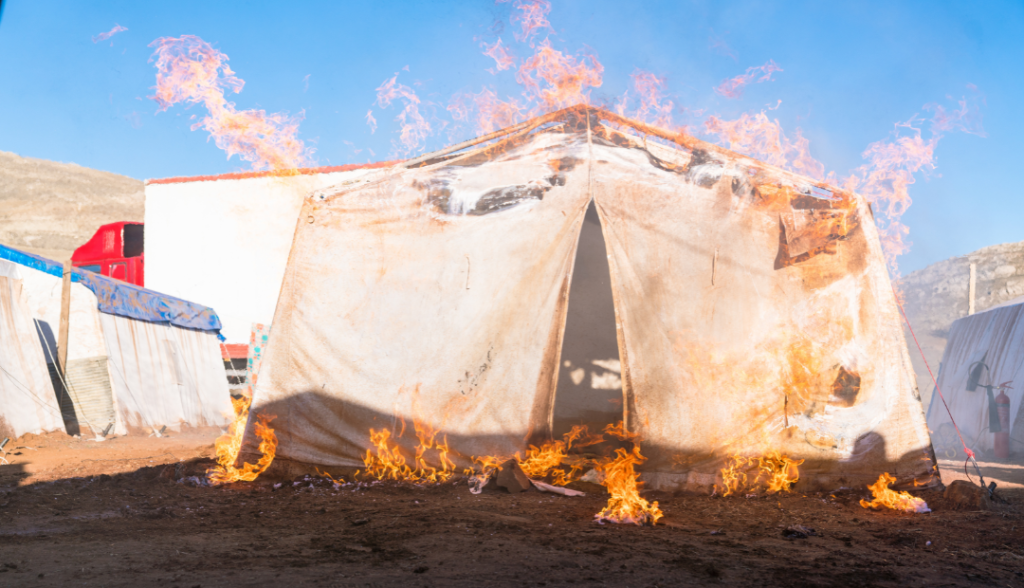Disaster Risk Reduction (DRR) practices are paramount in safeguarding vulnerable communities, especially in refugee camps where risks are heightened. The fire incident in Cox’s Bazar earlier this year serves as a stark reminder of the importance of effective DRR measures in saving lives and mitigating the impact of disasters.
DRR encompasses a range of strategies aimed at minimizing the vulnerabilities and enhancing the resilience of communities to natural hazards and disasters. From providing robust training programs on hazard response to developing innovative tools, DRR initiatives focus on proactive measures rather than reactive responses.
Challenges in Last Resort Sites
Last resort sites, including informal settlements and collective centers, are particularly vulnerable to fire hazards due to various factors. These sites often consist of makeshift shelters constructed from highly flammable materials, such as tarpaulin and bamboo, making them susceptible to rapid fire spread. Additionally, using open flames for cooking and heating further increases the risk of ignition in densely populated areas.
In Cox’s Bazar, home to 33 last resort sites for Rohingya refugees, the risk of fire is exacerbated by overcrowding and inadequate infrastructure. The lack of proper fire safety measures and the absence of timely response mechanisms have posed significant challenges in preventing and mitigating fire incidents in these settings.
MOAS’s DRR Initiatives
In response to these risks, MOAS has been at the forefront of DRR efforts in Cox’s Bazar. Through specialized training programs and innovative tools, volunteers are equipped with the necessary skills to effectively respond to emergencies. MOAS’s DRR initiatives are anchored in a comprehensive approach to address the specific vulnerabilities of refugee populations. Since 2019, MOAS has been providing Flood and Water Safety Training and Fire Response Training to refugees and host community volunteers.
The fire incident in January in Cox’s Bazar highlighted the inherent risks faced by refugees living in overcrowded camps. The fire, caused by unsafe cooking practices, razed over 1,000 shelters, leaving thousands homeless. Despite the magnitude of the blaze, no lives were lost, thanks to the rapid response of MOAS’s incredible team of volunteers.
Expanding DRR Practices to North East Syria
Building on the success of our program, MOAS is now planning to expand its DRR trainings to North East Syria (NES), where displaced communities face similar challenges, with a focus on fire safety and response.
In the northeast of Syria (NES), where over 300,000 internally displaced persons (IDPs) reside in various last resort sites, the risks of fire hazards are multifaceted and severe, necessitating immediate attention and intervention. Residents of informal settlements, characterized by self-settled areas on private or government-owned land, face dire challenges. Poor shelter conditions coupled with unsafe cooking practices contribute to a high risk of fires. An assessment by REACH revealed that 84% of these sites employed unsafe practices, with over half resorting to burning garbage for heating. The soaring gas prices have rendered cooking fuel unaffordable for many residents, exacerbating the situation and leading to increased reliance on hazardous alternatives.
Collective centers, which are usually repurposed public buildings, present their own set of challenges. While concrete construction generally lowers the fire risk compared to informal settlements, the use of diesel heaters poses dangers. Instances of unsafe usage, such as chimney pipes protruding dangerously, further compound the risks, necessitating immediate remedial actions.
In camps, where the majority of sites remain tented, the fire risk is also acute. The proximity of tents poses a constant threat of rapid fire spread. Modifications to shelters and self-built constructions further exacerbate the risks, with heaters and stoves being the primary causes of fires. The existing fire breaks almost all fail to meet minimum standards, exacerbating the risk of fires spreading uncontrollably.
The alarming frequency of fire incidents in camps across NES, with 280 reported in 2023 alone and approximately 20 incidents in February 2024 resulting in tragic fatalities, underscores the urgent need for robust Disaster Risk Reduction (DRR) initiatives. By collaborating with local stakeholders and leveraging its expertise, MOAS seeks to navigate these complexities and deliver impactful solutions to vulnerable communities.
Final Thoughts
The importance of robust DRR practices cannot be overstated. By learning from past experiences and embracing innovative solutions, we can mitigate the impact of disasters and ensure the safety and well-being of displaced populations worldwide. Join us in our mission to strengthen resilience and save lives. Together, we can make a difference.
If you are interested in the work of MOAS and our partners, please follow us on social media, sign up for our newsletter and share our content. You can also reach out to us at any time via [email protected]. If you want to support our operations, please give what you can at www.moas.eu/donate.


